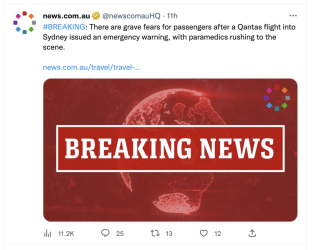milehighclub
Established Member
- Joined
- Feb 2, 2007
- Posts
- 1,817
No, sadly, it's standard journalism.This is really sloppy journalism.
"Neil's special "One Engine, One Leaf" salad - specially curated for this flight by Rockpool's NZ catering department (the nearest dairy to AKL) served with no hot towels.More importantly, does anyone have any pictures? I mean of the meal in J.
Obviously not too concerned about the engine if able to use reverse thrust. 34L is 3.9km long and in a 737 you’d have no problem stopping…Already had a colleague send me the thrust reverser open pic as though damn QF and spewing AJ malarkey smh.
I just said yeah the thrust reverser. that shut him up.
To resurrect an old joke, so if the last engine goes out they'll be up there forever.... slowed to ~380kts ground speed.
If the engine is in fact shut down, we still pull both reversers on landing. They’re hydraulically operated. The sleeve will still open and you’ll get idle reverse as opposed to full reverse on the other engine.Obviously not too concerned about the engine if able to use reverse thrust. 34L is 3.9km long and in a 737 you’d have no problem stopping…
Well- I learnt something here. We have the same word in German (same spelling even!) and it never occurred to me that this might be where the PAN PAN comes from. Mind boggling realisation!It is a backronyn.
(It derives from the French Panne (breakdown))
g. if voice communication is used, use the radiotelephony distress signal (MAYDAY) or urgency signal (PAN PAN) preferably spoken three times, as appropriate; and
h. establish communications with and alert nearby aircraft by broadcasting at suitable intervals on the frequency in use and on 121.5 MHz (or, as a backup, on the inter-pilot air-to-air frequency 123.45 MHz): 1. aircraft identification; 2. flight level; 3. position including the ATS route designa-tor or the track code, as appropriate; 4. the nature of the distress condition; and 5. intentions.
He managed to get himself a great deal. QF serviced his exQF 707 while he saunters around in a Pilot's uniform with the QF big boys. He even got a custom rego N707JThands of a Qantas pilot
Who would pick up the squawk 7700 when out of VHF range? And is 7700 mayday or pan?For those interested
No one would until within radar range. 7700 is strictly for Mayday. We leave the code as is for a Pan.Who would pick up the squawk 7700 when out of VHF range? And is 7700 mayday or pan?
It that company policy or standard across AU operators?No one would until within radar range. 7700 is strictly for Mayday. We leave the code as is for a Pan.
fascinating how the hot towel saga sneaked in herewith no hot towels
AU as far as I’m aware. 7700 is reserved for emergency. Now what the pilot deems to be an emergency is up to them. The manual also states that:It that company policy or standard across AU operators?
AFF Supporters can remove this and all advertisements
It that company policy or standard across AU operators?
Did... did they really just mistake the reversers for "engine damage"?
Also spotted this now deleted tweet from the same news outlet in my Twitter feed as well. I know they like to be click-baity but this is just pathetic lazy journalism.Did... did they really just mistake the reversers for "engine damage"?
I mean I'm not at all surprised, not one bit, but holy moly that's a doozie.


